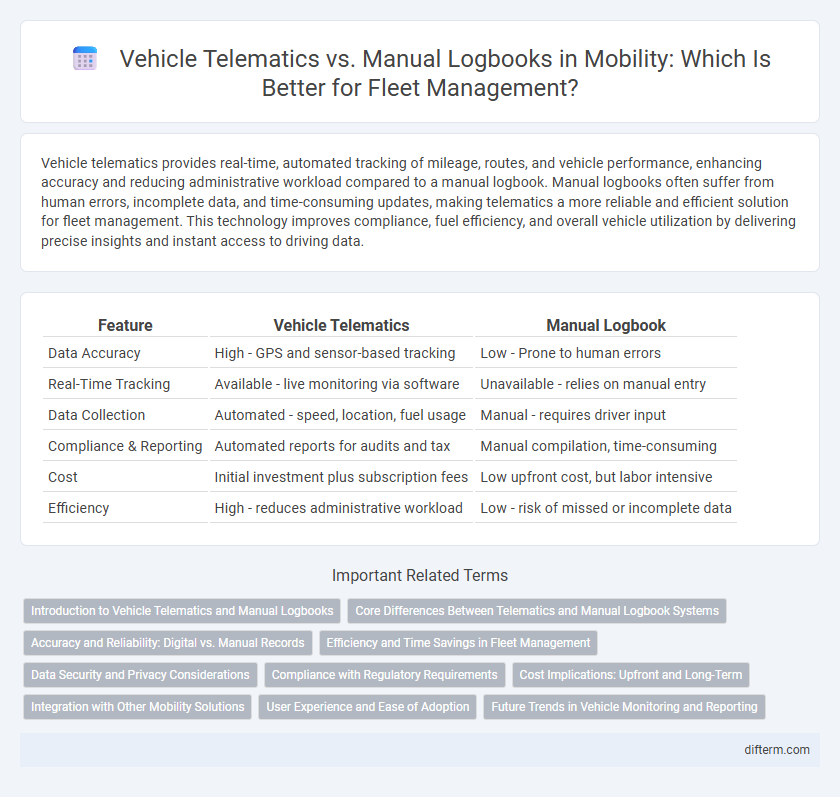Vehicle telematics provides real-time, automated tracking of mileage, routes, and vehicle performance, enhancing accuracy and reducing administrative workload compared to a manual logbook. Manual logbooks often suffer from human errors, incomplete data, and time-consuming updates, making telematics a more reliable and efficient solution for fleet management. This technology improves compliance, fuel efficiency, and overall vehicle utilization by delivering precise insights and instant access to driving data.
Table of Comparison
| Feature | Vehicle Telematics | Manual Logbook |
|---|---|---|
| Data Accuracy | High - GPS and sensor-based tracking | Low - Prone to human errors |
| Real-Time Tracking | Available - live monitoring via software | Unavailable - relies on manual entry |
| Data Collection | Automated - speed, location, fuel usage | Manual - requires driver input |
| Compliance & Reporting | Automated reports for audits and tax | Manual compilation, time-consuming |
| Cost | Initial investment plus subscription fees | Low upfront cost, but labor intensive |
| Efficiency | High - reduces administrative workload | Low - risk of missed or incomplete data |
Introduction to Vehicle Telematics and Manual Logbooks
Vehicle telematics systems utilize GPS tracking, real-time data collection, and automated reporting to provide accurate insights into vehicle usage, driver behavior, and maintenance needs, enhancing fleet management efficiency. Manual logbooks require drivers to record trip details by hand, which can lead to inaccuracies, time-consuming paperwork, and limited data visibility. Advanced telematics solutions improve compliance with regulations, reduce administrative burdens, and allow for proactive vehicle maintenance compared to traditional logbook methods.
Core Differences Between Telematics and Manual Logbook Systems
Vehicle telematics systems automatically capture real-time data such as GPS location, speed, fuel consumption, and driving behavior, while manual logbook systems rely on driver-entered records prone to human error and omissions. Telematics offers continuous, accurate monitoring with instant data transmission to fleet managers, enhancing operational efficiency and compliance, unlike manual logbooks which require time-consuming physical documentation and audits. The integration of telematics supports advanced analytics and predictive maintenance capabilities, contrasting the static and limited insight provided by traditional logbook record-keeping.
Accuracy and Reliability: Digital vs. Manual Records
Vehicle telematics systems provide highly accurate and real-time data on location, speed, and engine diagnostics, significantly reducing human error inherent in manual logbooks. Digital records automatically capture and store detailed trip information, ensuring greater reliability and easier compliance with regulatory requirements. In contrast, manual logbooks are prone to inaccuracies due to forgetfulness or intentional manipulation, undermining the trustworthiness of mileage and usage data.
Efficiency and Time Savings in Fleet Management
Vehicle telematics systems automate data collection, enabling real-time tracking and analysis of fleet performance, which significantly reduces administrative tasks compared to manual logbooks. Automated logging minimizes human error and ensures accurate mileage, fuel consumption, and driver behavior records, leading to more efficient route planning and maintenance scheduling. Fleet managers save time on data entry and reporting, allowing for quicker decision-making and enhanced operational efficiency.
Data Security and Privacy Considerations
Vehicle telematics systems offer enhanced data security through encrypted transmissions and real-time monitoring, reducing the risk of unauthorized access compared to manual logbooks, which are susceptible to physical theft and tampering. Telematics provide granular data on vehicle usage and driver behavior while ensuring compliance with data protection regulations such as GDPR and CCPA by controlling access permissions and anonymizing sensitive information. Manual logbooks lack automated audit trails and rely heavily on user honesty, increasing vulnerabilities in maintaining driver privacy and overall data integrity.
Compliance with Regulatory Requirements
Vehicle telematics systems automate the collection and recording of trip data, ensuring precise compliance with regulatory requirements such as Hours of Service (HOS) and Electronic Logging Device (ELD) mandates. Manual logbooks are prone to human error, delays, and potential falsification, increasing the risk of non-compliance and associated fines. Leveraging telematics enhances fleet auditing accuracy and real-time reporting, which supports adherence to transport regulations and audit readiness.
Cost Implications: Upfront and Long-Term
Vehicle telematics significantly reduces long-term costs by automating data collection, minimizing human error, and enhancing fuel efficiency compared to manual logbooks, which require labor-intensive record-keeping and are prone to inaccuracies. Upfront investment in telematics systems may be higher, but the return on investment emerges from savings in maintenance, compliance, and administrative expenses over time. Companies adopting telematics experience improved fleet management cost control, leading to optimized operational budgets and reduced total cost of ownership.
Integration with Other Mobility Solutions
Vehicle telematics systems seamlessly integrate with GPS navigation, fleet management software, and real-time traffic updates, enabling comprehensive mobility solutions. Manual logbooks lack automated data synchronization, causing delays and potential errors in tracking vehicle usage and maintenance schedules. Integrating telematics enhances operational efficiency, accurate reporting, and proactive decision-making across mobility platforms.
User Experience and Ease of Adoption
Vehicle telematics offers a streamlined user experience by automating data capture such as mileage, routes, and driving behavior, reducing manual input errors common in traditional logbooks. The ease of adoption is enhanced through mobile app integration and real-time data access, allowing drivers to focus on the road rather than paperwork. Conversely, manual logbooks often suffer from time-consuming entry and inaccuracies, leading to lower compliance and frustration among users.
Future Trends in Vehicle Monitoring and Reporting
Vehicle telematics is rapidly evolving with advanced sensors and AI-powered analytics, enabling real-time data collection and predictive maintenance that far surpasses the accuracy and efficiency of manual logbooks. Future trends emphasize integration with IoT networks and cloud computing, facilitating seamless vehicle monitoring, automated reporting, and enhanced fleet management capabilities. These innovations are driving a shift towards smarter, data-driven mobility solutions that improve operational efficiency and reduce costs.
Vehicle telematics vs Manual logbook Infographic

 difterm.com
difterm.com